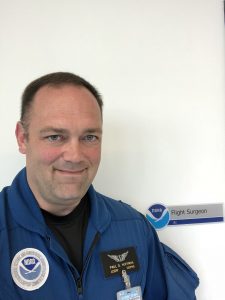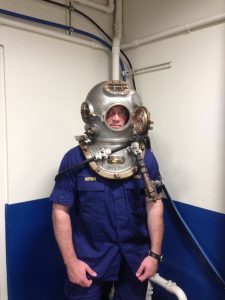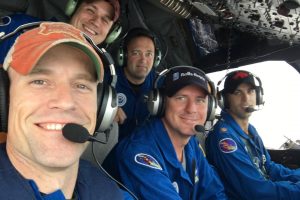Fit to Fly? PA Supports Hurricane Hunters
NOAA Director of Aviation Medicine Supports Pilots and Navigators
June 20, 2018
By Hillel Kuttler
When PA Paul Hoffman entered his Lakeland, Florida, office in November 2015, he found air-sickness bags taped to the walls. He received emails with attached photographs showing him losing it aboard a plane.
Hoffman smiled at his colleagues’ antics, but the previous day’s misery wasn’t humorous at the time. That’s when Hoffman flew on a P-3 Orion through Tropical Storm Kate over the Atlantic Ocean, something he’d never experienced before.
Few people do. Hoffman is the director of aviation medicine at the National Oceanic and Atmospheric Administration’s (NOAA) aircraft operations center. Most of his work is done on terra firma, where he examines NOAA’s pilots and navigators to certify their fitness to fly into the demanding storms, where their passengers-scientists study temperature, wind speed, and moisture.
[How to help provide emergency disaster services.]

Three times in his four and a half years on the job, Hoffman has tagged along on the flights, dubbed Hurricane Hunters, twice into tropical storms (Kate was later upgraded to a hurricane) and once into a hurricane. The latter mission included flying four ventures into the hurricane’s eye for up to 10 minutes at a time.
“It felt like a continuous roller coaster. There’s quite a bit of bumping and shaking. There’s lightning, blinding amounts of rain, hail, and ice,” he said of seeing Hurricane Matthew up close.
The initial upset stomach aside, Hoffman appreciates the novelty.
“It’s one of the cool things about my job. It’s pretty awesome. I didn’t have any responsibility on the aircraft, but it gave me an insight into what my aviators do,” Hoffman said while driving with his wife Janice through Virginia’s Shenandoah Valley on a recent vacation. “It was very valuable. Anytime you’re doing fitness-for-duty evaluations, it gives you a better concept of who’s fit and who isn’t when you realize what they have to do.”
He added: “There are a lot of people very dedicated to science and to their jobs, with significant personal risk involved, to support the American people. No one else flies into that on purpose. It’s a humbling position to realize that you’re able to participate in that in a medical-support role. It gave me a new appreciation for what our people do routinely.”
The stakes are high and responsibilities immense. The information scientists gather aboard NOAA’s nine aircraft is vital for forecasting storms and developing communities’ preparedness for them.
“If you can predict it, you can evacuate earlier, direct resources to support people after a hurricane hits, and decrease fatalities,” said Christian Rathke, MMSc, PA-C, director, office of health, based in NOAA’s office near Washington, D.C., and Hoffman’s supervisor.
NOAA’s mandate extends beyond hurricanes.
Other flights study wildlife and the receding glaciers related to global warming. The agency’s 16 ships assess the fish population along America’s coastline to help determine fish-catching limits, and study waterways to ensure that vessels can safely pass. Because of the economic implications of its work, NOAA is part of the Department of Commerce.
Safety is paramount, so Hoffman’s job “is absolutely critical,” said his on-site supervisor, Scott Price.
Hoffman is “far and away the best medical officer I’ve worked with,” Price said. “In fact, we have a survey every year, and Paul is recognized as the best thing we do here. … He’s a critical member of our safety culture, ensuring that all our aviators are safe to fly.”
Hoffman said that his work is akin to the Federal Aviation Administration’s certifying the fitness of pilots of civilian aircraft.
At NOAA, Hoffman also conducts routine screenings and other occupational-health examinations. Two days a week, he works 50 miles away, at MacDill Air Force Base, in Tampa. Patients there include pilots and navigators who are American and those from NATO allies posted there; employees of the Pentagon’s Central Command (known as CENTCOM), which is based at MacDill; and civilian employees.

As if that weren’t enough, Hoffman became a dive medical officer. His training covered treating divers’ injuries and understanding deep-sea effects on the body – crucial, given NOAA researchers’ science-related diving.
Hoffman took several detours en route to NOAA.
While working as a counselor at a home for at-risk boys, his cousin enrolled in a PA program in their native Pennsylvania. Hoffman enlisted in the U.S. Army and later entered the Interservice PA Program. He was deployed twice to Iraq, totaling 16 months in Baghdad and in Mahmudiyah, primarily handling sick call and trauma care. Hoffman said he marveled at how medical equipment was sometimes used “in unique ways,” like when an explosive-ordnance technician employed a portable x-ray machine for a better look at weapons caches that American soldiers had found.
His next career steps developed serendipitously, too. At a Fort Rucker, Alabama, program to train as a flight surgeon, Hoffman met someone who told him about the U.S. Public Health Service (USPHS), an agency of the Department of Health and Human Services that assigns medical professionals to federal offices. He applied to the USPHS and was dispatched to the Indian Health Service, in northern California. He served in rural clinics there for three years before being transferred to NOAA.
Although now a civilian employee, Hoffman occupies the rank of lieutenant commander in the USPHS. (He was a captain in the U.S. Army.) His military experience was invaluable, instilling “a mind-set, a thought process,” for employing “important life-saving techniques” in challenging conditions, he said.
“It forced me to become self-reliant, accept responsibility, and made me appreciate good resources,” he explained.
At NOAA, he said, “If I have a pilot deployed to Antarctica for three months flying in extreme conditions, I can understand how significant a risk he’ll face without the support. Having been in the Army in austere conditions, I can make better decisions on his fitness for duty. Or, if my guy’s heading into a hurricane, I understand what a 5-, 6-, 10-hour evacuation might be like.”
Price mentioned two cases when Hoffman’s cool-headed thinking aided the patient.

Once, an NOAA corps member suffered a stroke. Hoffman treated him immediately, then sped him to a hospital and briefed the medical staff there. Another time, Hoffman treated a civilian who’d suffered a panic attack, then monitored the man for a year, including adjusting his medications.
For his handling of the cases, Hoffman in 2017 was awarded the NOAA Corps Commendation Medal, “which is a pretty big deal around here,” Price said.
“Without a doubt, he had a very, very positive impact on the outcomes,” Price added. “Paul is absolutely a superstar. He’s one of the finest officers I’ve worked within 19 years. That sounds dramatic, but it’s the truth.”
Hoffman recommends his line of work to other PAs.
“I don’t know of anybody who’s a PA who gets to fly into hurricanes, gain additional training as a dive medical officer, and plan for natural disasters. Medicine doesn’t have to be a 9-to-5 position. There’s not a lot of boredom when you get to do a lot of training and unique, interesting deployments,” he said.
“You have the opportunity to serve people and get a lot of personal gratification from realizing that the mission continues safely in part because of the medical support that I am privileged to provide. I had no idea at the outset of my career that I’d be in a position that offered me these opportunities.”
Hillel Kuttler is a freelance writer. Contact him at [email protected].
Thank you for reading AAPA’s News Central
You have 2 articles left this month. Create a free account to read more stories, or become a member for more access to exclusive benefits! Already have an account? Log in.



